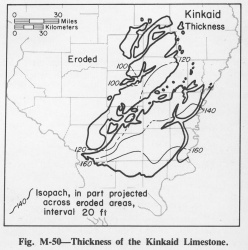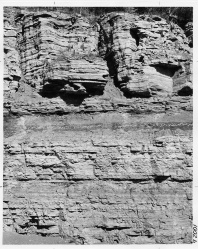Kinkaid Limestone
Lithostratigraphy: Pope Megagroup >>Kinkaid Limestone
Chronostratigraphy: Paleozoic Erathem >>Mississippian Subsystem >>Chesterian Series >>Elviran Stage
Allostratigraphy: Kaskaskia Sequence
Primary source
Willman, H. B., Elwood Atherton, T. C. Buschbach, Charles Collinson, John C. Frye, M. E. Hopkins, Jerry A. Lineback, and Jack A. Simon, 1975, Handbook of Illinois Stratigraphy: Illinois State Geological Survey Bulletin 95, 261 p.
Contributing author(s)
Elwood Atherton, Charles Collinson, and Jerry A. Lineback
Name
Original description
Kinkaid Formation (S. Weller, 1920, p. 281-290; Swann, 1963, p. 42).
Derivation
Named for Kinkaid Creek, Jackson County.
Other names
History/background
Type section
Type location
The type section of the Kinkaid Formation is in exposures along the Kinkaid Creek (SE NW NW 6, 8S-4W).
Type author(s)
Type status
Reference section
Reference location
Reference author(s)
Reference status
Stratigraphic relationships
Extent and thickness
The Kinkaid is one of the thicker Chesterian formations, commonly 120-160 feet thick. However, pre-Pennsylvanian erosion of valleys trending northeast-southwest has cut the formation, and particularly its upper member, into isolated areas (Bristol and Howard, 1971, 1974). The formation appears to have been highly resistant to erosion, because it caps the Chesterian Series in large areas, and slump blocks of Kinkaid occur on the slopes of steep-walled pre-Pennsylvanian valleys. The formation ranges from about 100 feet thick in the north to a little more than 170 feet near its southern margin (fig. M-50).
Lithology
The Kinkaid is a limestone-shale unit (fig. M-1C). It is divided into three members-- the Negli Creek Limestone Member (below), the Cave Hill Shale Member, and the Goreville Limestone Member.
Core(s)
Photograph(s)
Contacts
Well log characteristics
Fossils
The fauna of the Kinkaid is dominantly brachiopods, bryozoans, and blastoids and resembles that of several older Chesterian limestone formations, although it is less prolific. A species of Martinia is very common.
Age and correlation
Environments of deposition
Economic importance
Remarks
References
BRISTOL, H. M., and R. H. HOWARD, 1971, Paleogeologic map of the sub-Pennsylvanian Chesterian (upper Mississippian) surface in the Illinois Basin: Illinois State Geological Survey Circular 458, 14 p.
BRISTOL, H. M., and R. H. HOWARD, 1974, Sub-Pennsylvanian valleys in the Chesterian surface of the Illinois Basin and related Chesterian slump blocks, in Carboniferous of the southeastern United States: Symposium, Geological Society of America Special Paper 148, p. 315-336; Illinois State Geological Survey Reprint 1974-T.
SWANN, D. H., 1963, Classification of Genevievian and Chesterian (Late Mississippian) rocks of Illinois: Illinois State Geological Survey Report of Investigations 216, 91 p.
WELLER, STUART, 1920, Chester Series in Illinois: Journal of Geology, v. 28, p. 281-303, 395-416.
ISGS Codes
| Stratigraphic Code | Geo Unit Designation |
|---|---|

